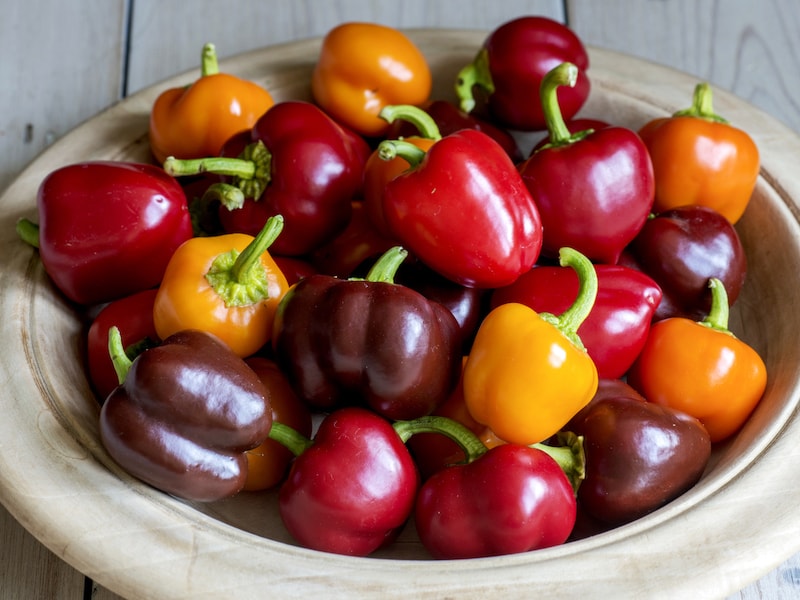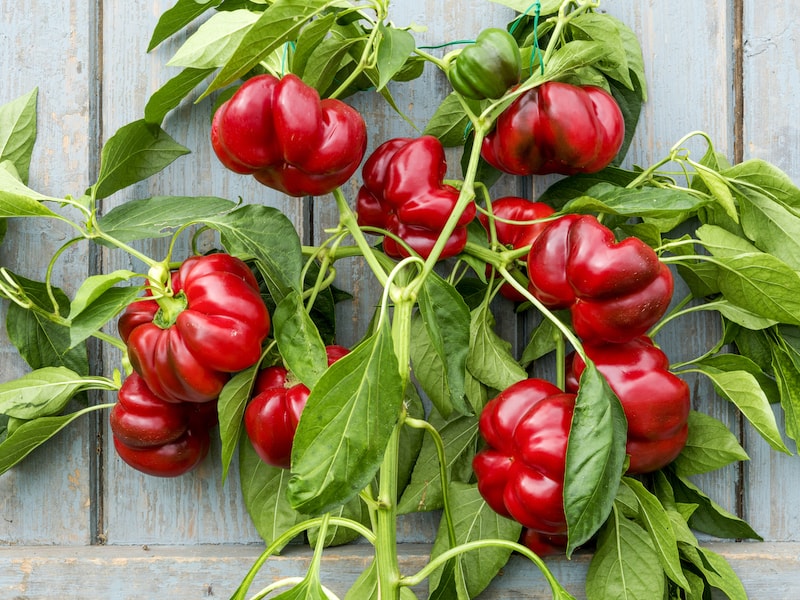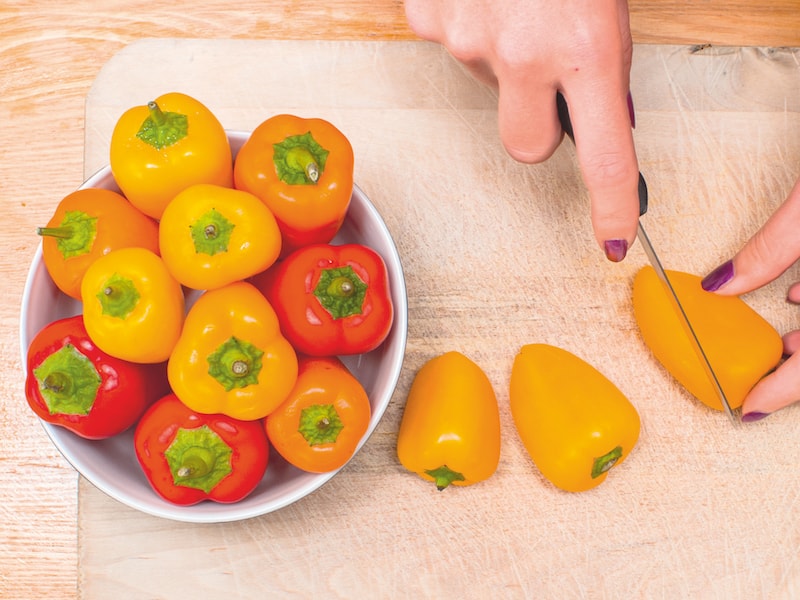Homegrown sweet peppers come in a wide variety of shapes, sizes and colours, and are perfectly happy in containers or the ground. They need a warm environment and a long growing season to thrive, but with a few expert tips, they’re not too difficult to grow. Here are some of the most helpful articles, videos and Instagram posts to get you off to a good start – and help you troubleshoot any pesky pepper problems along the way!
Ready to have a go? Browse our collection of flavoursome sweet pepper seeds or order some sweet pepper plants if you’re short on time and space.
Contents:
- Best advice on sowing sweet pepper seeds
- Best advice on where to grow sweet peppers
- Best advice on caring for sweet peppers
- Preserving and cooking with sweet peppers
Best advice on sowing sweet pepper seeds

Image: Sweet Pepper ‘Snackbite Mix’ seeds from Suttons
Over at @sams_growing_n_life, Sam gave her peppers a great head start by sowing the seeds indoors under warming lights in January. By April, when it was time to transfer her plant to the greenhouse, it already had little fruits appearing! If you grow your sweet peppers in containers, Sam recommends dwarf varieties. Visit her food-growing diary on Instagram to find out why.
Peter of About Thyme Gardening also sows his sweet pepper seeds in January, but uses a heated propagator in his greenhouse. Peppers hate to be cold, so he stands the pots of compost “in trays of hot water for 20 minutes” before sowing. Peter’s comprehensive blog post on how to grow sweet peppers from start to finish includes lots of great advice on everything from equipment and compost to the different varieties you might like to try.
To avoid a glut of sweet peppers, Claire Burgess shares some sensible advice: “The germination rate for peppers does tend to be pretty good, so only sow what you reckon you’ll use and maybe a few more.” Claire sows sweet pepper seeds in her greenhouse in April, as she finds the UK climate too cool to grow them outside. Watch the full video over at Claire’s Allotment to see how quick and easy it is.
Peppers benefit from early sowing, says Mandy Watson of MandyCanUDigIt, but don’t worry “if you can’t provide enough heat and light for germination and growing on”. Just buy young plants in spring. Whether you buy seeds, plugs or grafted plants, Mandy recommends planting a clove of garlic with every pepper to protect it from greenfly. “The peppers draw up the insecticidal properties of the garlic, so whatever sucks the sap doesn’t last long,” she explains.
Best advice on where to grow sweet peppers

©Floramedia
Sweet peppers love a sunny spot, says Ben Vanheems of Grow Veg and, in warmer areas, your peppers can be grown successfully outdoors provided they get at least six hours of direct sunlight every day. If you live somewhere cooler, he recommends giving them a head start under cover. “Peppers will come into flower far quicker if they’re grown on with the added protection of a greenhouse, polytunnel or conservatory,” he says.
Suzanne Walsh at @the_no_dig_gardener successfully grew ‘Corno Di Toro Rosso’ peppers outside this year, after seeing another UK gardener doing it. She describes this variety as “prolific, large, flavourful, and sweet,” and says that her plant has continued to fruit even into October.
Emma Doughty, AKA The Unconventional Gardener, has grown sweet peppers outside and indoors. She’s even grown them on a sunny office windowsill where “they were a big hit with colleagues!” She recommends growing peppers in containers, as “a certain amount of root restriction encourages peppers to fruit.” Want to know how to encourage your peppers to ripen at the end of summer? Read Emma’s article for top tips.
Wherever you decide to grow your peppers, keeping them warm is the key to success, says the home gardener behind @glebecottagegardenkitchen. Here in the UK, peppers are best grown “in a greenhouse, polytunnel, conservatory or coldframe”, but if you decide to grow them outside, she recommends a cloche or fleece protection. This gardener grew her experimental crop of sweet peppers from saved seeds. Check out the images on Instagram!
Best advice on caring for sweet peppers

Image: Sweet pepper plants from Suttons
Young pepper plants sometimes need a bit of support while they’re growing. Helen from @planting_for_fun gently secures her pepper plants to stakes with some soft string, which helps to keep them upright as they continue to get bigger. Check out the images of her green and yellow sweet peppers for inspiration!
For bushier plants that provide bumper crops, head over to Ivan’s Gardening Allotment UK to watch his video on ‘topping’ your sweet pepper plants. Ivan beautifully demonstrates how to remove the top of a young pepper plant by cutting above the third set of ‘true leaves’ with a sharp, sterilised pair of scissors. Want to see the results? Check out his follow-up video to see how his topped pepper plants progressed.
Bargain-hunter Penny, from Penny Golightly, recommends watering your sweet pepper plants with diluted cold black tea and “mulching with used tea leaves halfway through the growing season”. Why? Sweet peppers prefer acidic soil, she explains. Read the full article for loads of thrifty tips and tricks to help you get the best sweet pepper crop on a budget.
Sweet peppers can be susceptible to aphid attack, but don’t reach for the pesticides too quickly, warns Tony O’Neill of Simplify Gardening. If you’ve spotted an aphid infestation, check your plant for ladybirds and their larvae which “typically appear just as the aphids are about to overwhelm your plants”. If you’re lucky, the ladybirds will despatch these unwanted pests in a matter of days.
Preserving and cooking with sweet peppers

Image: Sweet Pepper ‘F1 Snackbite Mix’ seeds from Suttons
If you’re wondering what to do with a glut of sweet peppers, Chris from @veggieplot shares his recipe for “sweet red pepper fridge pickles” that tastes as delicious as it looks! Head over to his Instagram account to learn this simple method for turning excess peppers into a tasty preserve that you can enjoy at any time of the year.
Hummus is easy to make and tastes even better when made with homegrown ingredients, as you can see from this red pepper hummus recipe over at Rekha’s Garden and Kitchen. Rekha grills the peppers and then covers them with kitchen film to soften the skins, making them easier to peel before blending with the chickpeas.
Sweet peppers are hugely versatile, and growing your own means you can try tasty new varieties that aren’t available from supermarkets. We hope our bloggers have inspired you to have a go – share your photos on Instagram using #mysuttonsjourney
Lead image: Sweet Pepper ‘F1 Cardinal’ (Purple) seeds from Suttons
Last Updated on December 11, 2024 by Suttons Horticultural Team





thanks for sharing such an informative article.